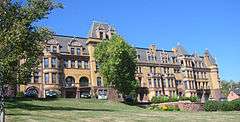Munger Terrace
|
Munger Terrace | |
 | |
  | |
| Location | 405 Mesaba Ave., Duluth, Minnesota |
|---|---|
| Coordinates | 46°47′9″N 92°6′33″W / 46.78583°N 92.10917°WCoordinates: 46°47′9″N 92°6′33″W / 46.78583°N 92.10917°W |
| Built | 1891–92 |
| Architect | Oliver G. Traphagen and Francis W. Fitzpatrick |
| Architectural style | Richardsonian Romanesque, chateauesque, Renaissance |
| NRHP Reference # | 76002176 |
| Added to NRHP | December 12, 1976 |
Munger Terrace is a landmarked apartment block in Duluth, Minnesota, United States. It was originally eight luxury townhouses.
The building, in brick with brownstone trim, was constructed in 1891-92 for Roger S. Munger, an important early Duluth entrepreneur, on a site next to his Victorian Gothic mansion;[1] the houses were rentals, Munger's only such project. The architects were Oliver G. Traphagen and Francis W. Fitzpatrick; the style of the building is sometimes described as Richardsonian Romanesque revival[2][3] sometimes as "Châteauesque."[4][5][6] The National Register of Historic Places lists it as Renaissance.[7][8] The townhouses were all different and had sixteen rooms, separate front and back stairs, central steam heat, running water on all floors, gas for cooking, and electric lighting. The site on the Central Hillside below North 5th Street between North 4th and North 5th Avenues West was three blocks above the tower of the Post Office downtown, and gardens with fountains and a gazebo were laid out on the slope in front of the building.
The project's original name was Piedmont Terrace, but Piedmont Avenue below was renamed Mesabi Avenue and is now Mesaba Avenue; a different Duluth street is now called Piedmont Avenue. The current address of the building is 405 Mesaba Avenue.
One of the original tenants was the Benedictine Sisters, who rented the three westernmost units (6 through 8) and used two rooms on the second floor of unit 8 as a chapel. They started a school there that was a forerunner of the College of St. Scholastica.[9][10][11][12][13][14] The nuns left after outgrowing the space.
Munger's house was demolished in 1955. Its carriage house, on 5th Street, has been retained as a caretaker's house but its trim has been removed.[15] In 1915 the townhouses were divided into apartments.[4][16] In the 1970s Mesaba Avenue was widened and much of the land in front of the building lost; what is left is a lawn, and that part of 4th Avenue is now a step street. Munger Terrace was placed on the National Register of Historic Places on December 12, 1976.[4] In 1978-79 the building was extensively rehabilitated by the non-profit Town View Improvement Corporation,[17] with new windows, skylights, roof, heating, utilities, and kitchen equipment and the addition of sprinklers. It remains rental accommodation.
References
- ↑ James Allen Scott, John R. Ulven, and Robert T. Calton, Duluth's Legacy: Text, Legacy Series (Duluth), Duluth: Department of Research and Planning, 1974, ISBN 0-914582-00-3, p. 83.
- ↑ David Gebhard and Tom Martinson, A Guide to the Architecture of Minnesota, University Gallery of the University of Minnesota/Minnesota Society of Architects, Minneapolis: University of Minnesota, 1977, ISBN 0-8166-0775-3, p. 190.
- ↑ Alan K. Lathrop, "Architecture in Minnesota at the Turn of the Century" in Michael Conforti, ed., Minnesota 1900: Art and Life on the Upper Mississippi, 1890-1915, Newark: University of Delaware, 1994, ISBN 0-87413-560-5, pp. 23-62, p. 34: "Traphagen . . . specialized in the Richardsonian style. . . . His First Presbyterian Church (1891), Chester Terrace apartments (1890), and Munger Terrace flats (1891-92) are outstanding examples of his skill".
- 1 2 3 Mary Ann Nord, The National Register of Historic Places in Minnesota: A Guide, St. Paul: Minnesota Historical Society, 2003, ISBN 978-0-87351-448-4, p. 230.
- ↑ Susan Stanich and Janet Blixt, The Insiders' Guide to the Lake Superior Region, Duluth: Insider's Guides, 1996, ISBN 978-0-912367-92-7, p. 340.
- ↑ Sheldon T. Aubut and Maryanne C. Norton, Duluth, Minnesota, Images of America, Chicago: Arcadia, 2001, ISBN 978-0-7385-1891-6, p. 81.
- ↑ National Register Information System no. 76002176
- ↑ Minnesota, St. Louis County, National Register of Historic Places listing, American Dreams, Inc.
- ↑ Dwight Edwards Woodbridge and John Stone Pardee, History of Duluth and St. Louis County, Past and Present, Chicago: Cooper, 1910, Volume 2, p. 596.
- ↑ The Catholic Church in the United States of America: Undertaken to Celebrate the Golden Jubilee of His Holiness, Pope Pius X, Volume 2, New York: Catholic Editing Company, 1914, p. 24.
- ↑ Acta et Dicta 5 (1917) p. 284.
- ↑ Merrill E. Jarchow, Private Liberal Arts Colleges in Minnesota: Their History and Contributions, St. Paul: Minnesota Historical Society, 1973, ISBN 978-0-87351-081-3, p. 132.
- ↑ "About the College of St. Scholastica," Opinion, Duluth News Tribune September 12, 2010.
- ↑ Our Benedictine Monastery History, St. Scholastica Monastery, retrieved February 19, 2011.
- ↑ Aubut and Norton, p. 80.
- ↑ Deborah Morse-Kahn, Lake Superior's Historic North Shore: A Guided Tour, St. Paul: Minnesota Historical Society, 2008, ISBN 978-0-87351-621-1, p. 39.
- ↑ West's Federal Reporter 1989, p. xcvi.
External links
-
 Media related to Munger Terrace at Wikimedia Commons
Media related to Munger Terrace at Wikimedia Commons